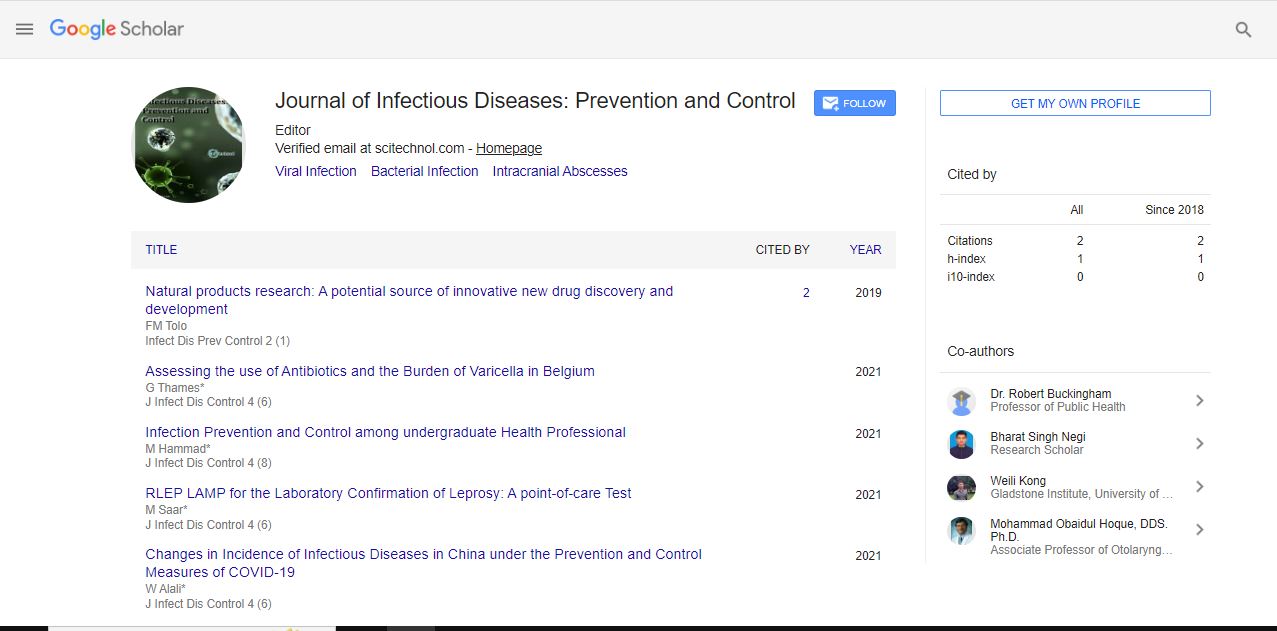Opinion Article, Vol: 6 Issue: 1
Symptoms, Causes, and Treatment of Clinical Infectious Diseases
Michelle M. Kameda*
Department of Surgery, McMaster University, Hamilton, Ontario, Canada
*Corresponding Author: Michelle M. Kameda
Department of Surgery, McMaster
University, Hamilton, Ontario, Canada
E-mail: dasmith77320@gmail.com
Received date: 21 February, 2023, Manuscript No. IDPC-23-95702;
Editor assigned date: 23 February, 2023, Pre QC No. IDPC-23-95702(PQ);
Reviewed date: 07 March, 2023, QC No. IDPC-23-95702;
Revised date: 14 March, 2023, Manuscript No. IDPC-23-95702(R);
Published date: 24 March, 2023, DOI: 10.36648/idpc.5.2.128
Citation: Kameda MM (2023) Symptoms, Causes, and Treatment of Clinical Infectious Diseases. Infect Dis Prev Control 6:1.
Description
Clinical infectious diseases refer to illnesses caused by infectious agents such as bacteria, viruses, fungi, and parasites. These diseases are a significant public health concern, affecting individuals of all ages, backgrounds, and geographical locations [1]. They can range in severity from mild, self-limiting illnesses to life-threatening conditions. Some of the common clinical infectious diseases, their symptoms, causes, and treatments [2].
Pneumonia
Pneumonia is an infection of the lungs that can be caused by bacteria, viruses, or fungi. It can affect people of all ages, but is most common in young children, older adults, and people with weakened immune systems. Symptoms of pneumonia can include cough, fever, chest pain, shortness of breath, fatigue, and confusion [3]. Treatment for pneumonia depends on the cause, but may include antibiotics, antiviral medications or antifungal medications [4].
Influenza
Influenza, commonly known as the flu, is a respiratory infection caused by the influenza virus. It is highly contagious and can spread through the air when an infected person coughs or sneezes. Symptoms of the flu can include fever, cough, sore throat, runny or stuffy nose, body aches, headache, chills, and fatigue [5]. Treatment for the flu may include antiviral medications, rest, fluids, and over-the-counter medications for symptom relief [6].
Hepatitis
Hepatitis is an inflammation of the liver that can be caused by viruses, drugs, or toxins. There are several types of hepatitis, including hepatitis A, B, C, D, and E, each with their own causes and treatments. Symptoms of hepatitis can include fatigue, nausea, vomiting, abdominal pain, and jaundice (yellowing of the skin and eyes). Treatment for hepatitis depends on the cause, but may include antiviral medications, steroids, or immunosuppressive drugs [7].
Malaria
Malaria is a parasitic infection that is spread through the bite of infected mosquitoes. It is most common in tropical and subtropical regions, and can be a life-threatening condition if left untreated. Symptoms of malaria can include fever, chills, headache, muscle aches, and fatigue. Treatment for malaria may include antimalarial medications, rest, and fluids [8].
Tuberculosis
Tuberculosis (TB) is a bacterial infection that can affect the lungs, as well as other parts of the body. It is spread through the air when an infected person coughs or sneezes [9]. Symptoms of TB can include cough, fever, weight loss, night sweats, and fatigue. Treatment for TB may include antibiotics for several months, as well as rest and a healthy diet.
HIV/AIDS
HIV (Human Immunodeficiency Virus) is a viral infection that attacks the immune system, and can progress to AIDS (Acquired Immunodeficiency Syndrome), a life-threatening condition [10]. HIV is spread through sexual contact, sharing needles or syringes, or from mother to child during pregnancy, childbirth, or breastfeeding. Symptoms of HIV can include fever, fatigue, weight loss, and swollen lymph nodes. Treatment for HIV includes antiretroviral therapy, which can help to slow the progression of the disease and improve quality of life.
Conclusion
In conclusion, clinical infectious diseases are a significant global health issue that requires ongoing attention and action from healthcare professionals, policymakers, and the general public. By working together, we can help prevent the spread of these diseases and improve outcomes for those who are affected. Preventing and controlling the spread of infectious diseases requires a multi-faceted approach that includes vaccination, effective infection control measures, and appropriate use of antimicrobial agents. Rapid diagnosis and treatment are also crucial for reducing the morbidity and mortality associated with these diseases.
References
- Chatterjee D, Saikia UN, Ramesh V (2021) Diagnostic dilemma of cutaneous tuberculosis: opening of the Pandora's box. Am J Dermatopathol 43: 871–880
[Crossref][Google Scholar][PubMed]
- Schlagenhauf P, Weld L, Goorhuis A, et al (2015) Travel-associated infection presenting in Europe (2008–12): an analysis of EuroTravNet longitudinal, surveillance data, and evaluation of the effect of the pretravel consultation. Lancet Infect Dis 15: 5564
- Pouletty M, De Pontual L, Lopez M, et al (2019) Multiplex PCR reveals a high prevalence of multiple pathogens in traveller's diarrhoea in children. Arch Dis Child 104: 141146
- Rogawski ET, Bartelt LA, Platts-Mills JA, et al (2017) Determinants and impact of Giardia infection in the first 2 years of life in the MAL-ED birth cohort. J Pediatric Infect Dis Soc 6: 153160
- Lengerich EJ, Addiss DG, Juranek DD (1994) Severe giardiasis in the United States. Clin Infect Dis 18: 760763
- Gilman RH, Marquis GS, Miranda E, et al (1988) Rapid reinfection by Giardia lamblia after treatment in a hyperendemic Third World community. Lancet 1: 343345
- Roy M, Singha B, Dhar D, Roychoudhury S (2019) Prevalence of Giardia intestinalis with other co-infecting parasites in Barak Valley, Assam, India: a molecular approach. J Parasit Dis 43: 426442
- Karanis P, Kourenti C, Smith H (2007) Waterborne transmission of protozoan parasites: a worldwide review of outbreaks and lessons learnt. J Water Health 5: 138
- Hanevik K, Wensaas KA, Rortveit G, et al (2014) Irritable bowel syndrome and chronic fatigue 6 years after Giardia infection: a controlled prospective cohort study. Clin Infect Dis 59: 13941400
- Nygard K, Schimmer B, Sobstad O, et al (2006) A large community outbreak of waterborne giardiasis-delayed detection in a nonendemic urban area. BMC Public Health 6: 141
 Spanish
Spanish  Chinese
Chinese  Russian
Russian  German
German  French
French  Japanese
Japanese  Portuguese
Portuguese  Hindi
Hindi 